RMIT PUBH1394 Assessment 2: Substance Abuse in Australia
VerifiedAdded on 2022/09/18
|7
|1678
|28
Report
AI Summary
This report, prepared for a nursing course, examines substance abuse as a significant public health concern in Australia. It begins with an overview of substance misuse, including both illicit drugs and misuse of legal substances like alcohol and tobacco, and highlights its alarming health consequences, particularly among young adults and the indigenous population. The report explores the social determinants of health contributing to substance abuse, such as lack of education, poor housing, financial constraints, and stress. It discusses the public health approach to addressing the issue, including early detection, community-based interventions, and government initiatives like the "Closing the Gap" policy. The report also assesses the effectiveness of various programs and surveys conducted by agencies like the Australian Institute of Health and Welfare (AIHW) and the Australian Drug Foundation to monitor and address substance abuse patterns, ultimately concluding that while progress is being made, particularly through web-based initiatives, more comprehensive strategies are needed to reduce the prevalence of substance abuse, especially in remote areas and among vulnerable populations.
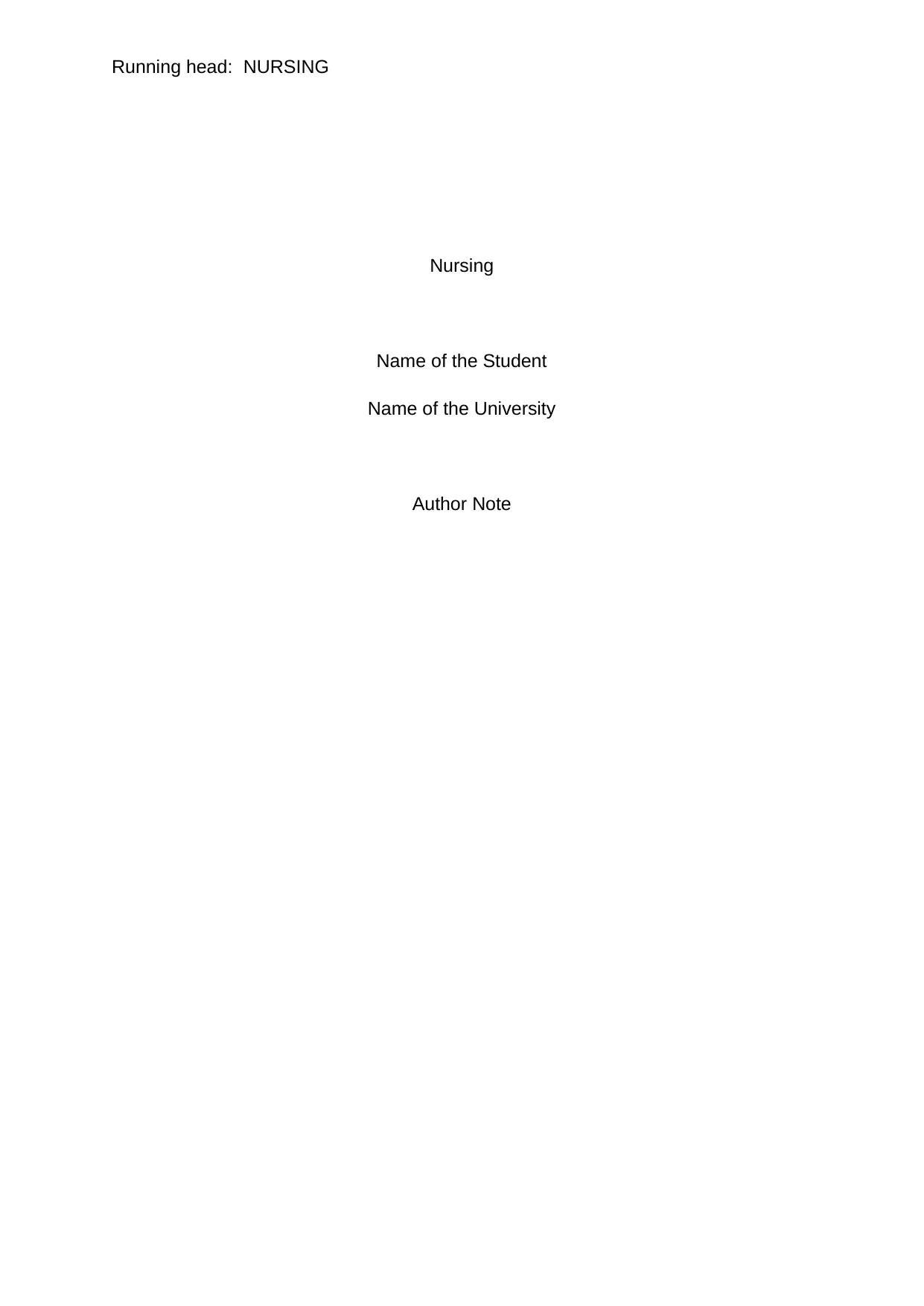
Running head: NURSING
Nursing
Name of the Student
Name of the University
Author Note
Nursing
Name of the Student
Name of the University
Author Note
Paraphrase This Document
Need a fresh take? Get an instant paraphrase of this document with our AI Paraphraser
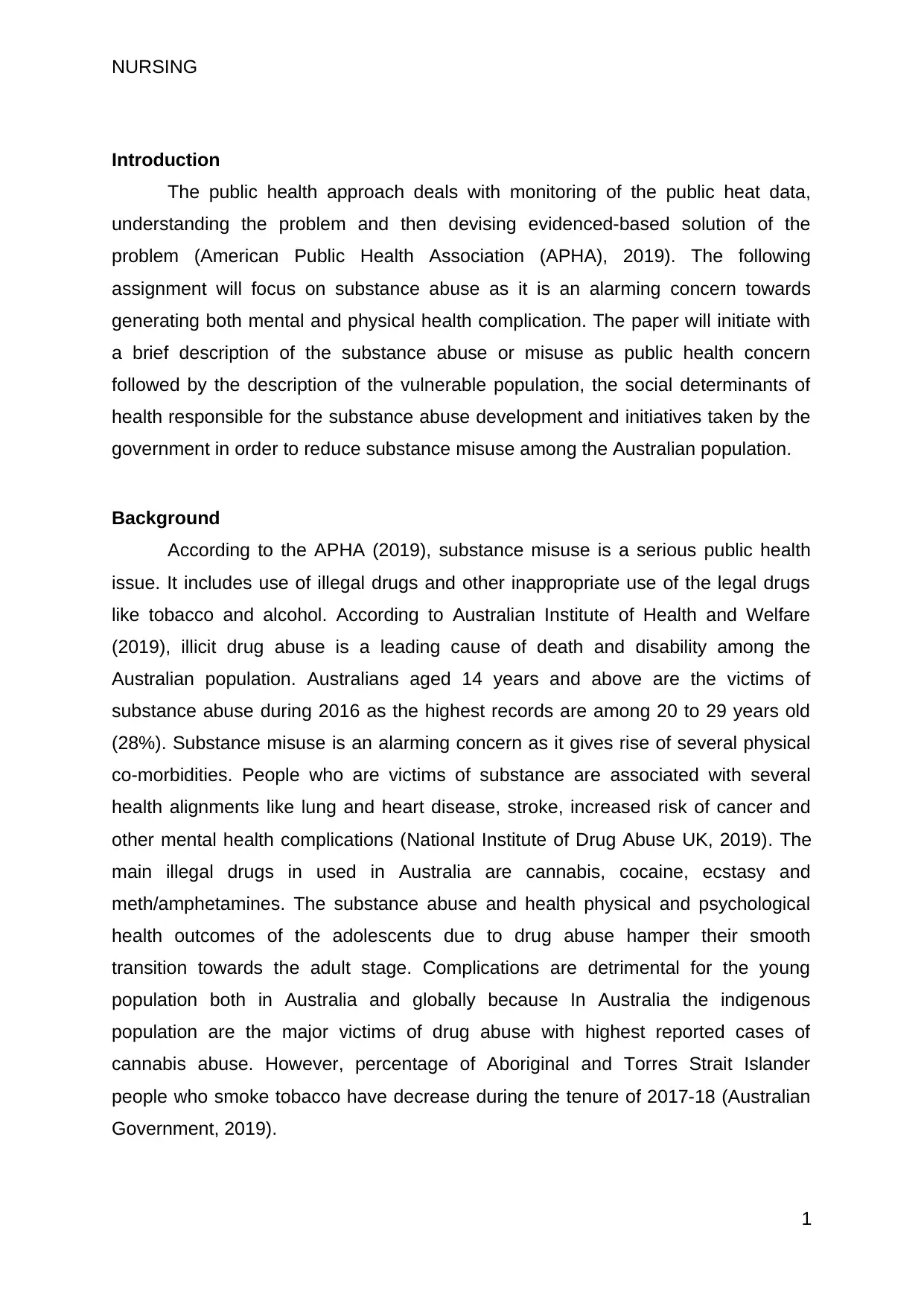
NURSING
Introduction
The public health approach deals with monitoring of the public heat data,
understanding the problem and then devising evidenced-based solution of the
problem (American Public Health Association (APHA), 2019). The following
assignment will focus on substance abuse as it is an alarming concern towards
generating both mental and physical health complication. The paper will initiate with
a brief description of the substance abuse or misuse as public health concern
followed by the description of the vulnerable population, the social determinants of
health responsible for the substance abuse development and initiatives taken by the
government in order to reduce substance misuse among the Australian population.
Background
According to the APHA (2019), substance misuse is a serious public health
issue. It includes use of illegal drugs and other inappropriate use of the legal drugs
like tobacco and alcohol. According to Australian Institute of Health and Welfare
(2019), illicit drug abuse is a leading cause of death and disability among the
Australian population. Australians aged 14 years and above are the victims of
substance abuse during 2016 as the highest records are among 20 to 29 years old
(28%). Substance misuse is an alarming concern as it gives rise of several physical
co-morbidities. People who are victims of substance are associated with several
health alignments like lung and heart disease, stroke, increased risk of cancer and
other mental health complications (National Institute of Drug Abuse UK, 2019). The
main illegal drugs in used in Australia are cannabis, cocaine, ecstasy and
meth/amphetamines. The substance abuse and health physical and psychological
health outcomes of the adolescents due to drug abuse hamper their smooth
transition towards the adult stage. Complications are detrimental for the young
population both in Australia and globally because In Australia the indigenous
population are the major victims of drug abuse with highest reported cases of
cannabis abuse. However, percentage of Aboriginal and Torres Strait Islander
people who smoke tobacco have decrease during the tenure of 2017-18 (Australian
Government, 2019).
1
Introduction
The public health approach deals with monitoring of the public heat data,
understanding the problem and then devising evidenced-based solution of the
problem (American Public Health Association (APHA), 2019). The following
assignment will focus on substance abuse as it is an alarming concern towards
generating both mental and physical health complication. The paper will initiate with
a brief description of the substance abuse or misuse as public health concern
followed by the description of the vulnerable population, the social determinants of
health responsible for the substance abuse development and initiatives taken by the
government in order to reduce substance misuse among the Australian population.
Background
According to the APHA (2019), substance misuse is a serious public health
issue. It includes use of illegal drugs and other inappropriate use of the legal drugs
like tobacco and alcohol. According to Australian Institute of Health and Welfare
(2019), illicit drug abuse is a leading cause of death and disability among the
Australian population. Australians aged 14 years and above are the victims of
substance abuse during 2016 as the highest records are among 20 to 29 years old
(28%). Substance misuse is an alarming concern as it gives rise of several physical
co-morbidities. People who are victims of substance are associated with several
health alignments like lung and heart disease, stroke, increased risk of cancer and
other mental health complications (National Institute of Drug Abuse UK, 2019). The
main illegal drugs in used in Australia are cannabis, cocaine, ecstasy and
meth/amphetamines. The substance abuse and health physical and psychological
health outcomes of the adolescents due to drug abuse hamper their smooth
transition towards the adult stage. Complications are detrimental for the young
population both in Australia and globally because In Australia the indigenous
population are the major victims of drug abuse with highest reported cases of
cannabis abuse. However, percentage of Aboriginal and Torres Strait Islander
people who smoke tobacco have decrease during the tenure of 2017-18 (Australian
Government, 2019).
1
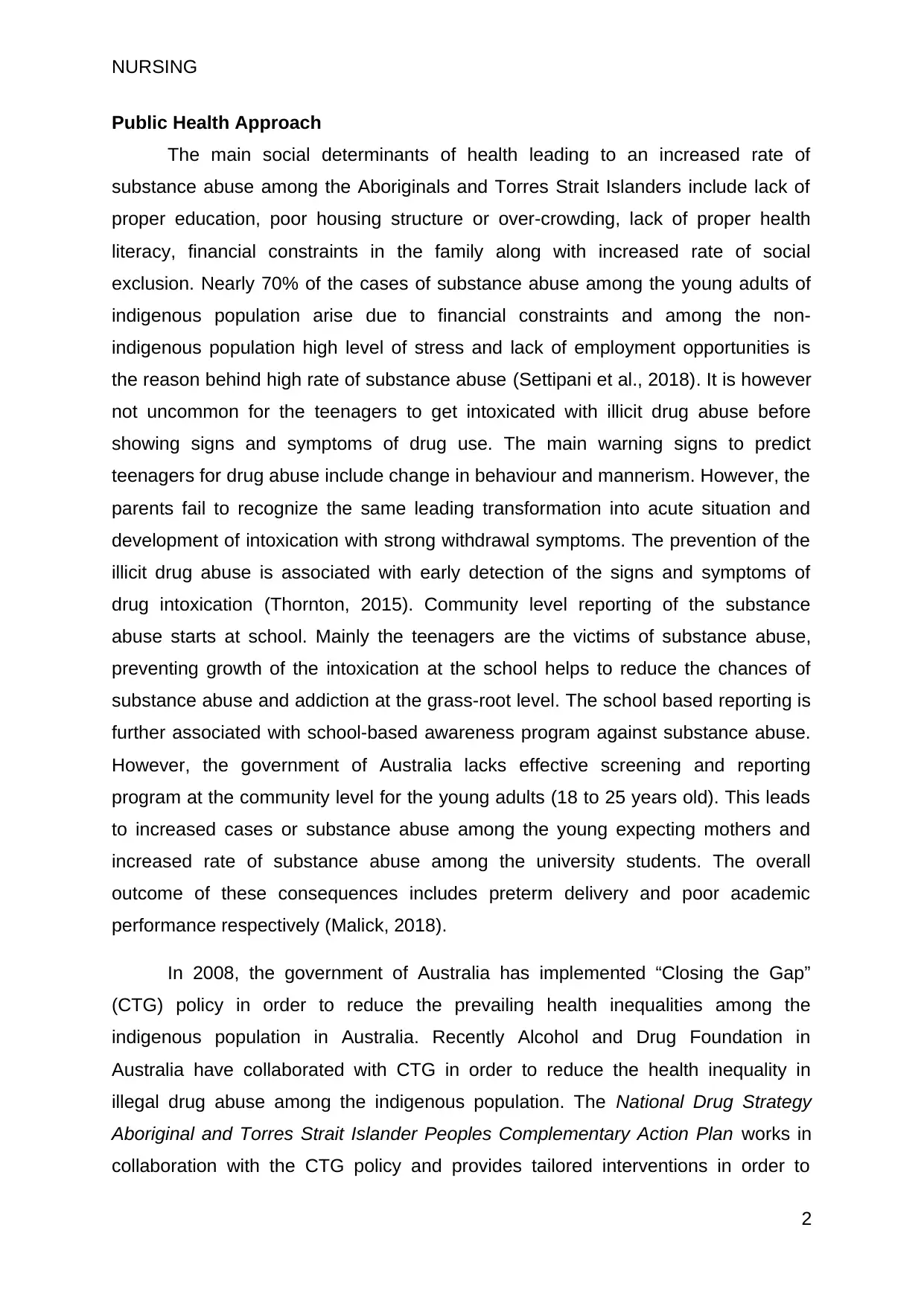
NURSING
Public Health Approach
The main social determinants of health leading to an increased rate of
substance abuse among the Aboriginals and Torres Strait Islanders include lack of
proper education, poor housing structure or over-crowding, lack of proper health
literacy, financial constraints in the family along with increased rate of social
exclusion. Nearly 70% of the cases of substance abuse among the young adults of
indigenous population arise due to financial constraints and among the non-
indigenous population high level of stress and lack of employment opportunities is
the reason behind high rate of substance abuse (Settipani et al., 2018). It is however
not uncommon for the teenagers to get intoxicated with illicit drug abuse before
showing signs and symptoms of drug use. The main warning signs to predict
teenagers for drug abuse include change in behaviour and mannerism. However, the
parents fail to recognize the same leading transformation into acute situation and
development of intoxication with strong withdrawal symptoms. The prevention of the
illicit drug abuse is associated with early detection of the signs and symptoms of
drug intoxication (Thornton, 2015). Community level reporting of the substance
abuse starts at school. Mainly the teenagers are the victims of substance abuse,
preventing growth of the intoxication at the school helps to reduce the chances of
substance abuse and addiction at the grass-root level. The school based reporting is
further associated with school-based awareness program against substance abuse.
However, the government of Australia lacks effective screening and reporting
program at the community level for the young adults (18 to 25 years old). This leads
to increased cases or substance abuse among the young expecting mothers and
increased rate of substance abuse among the university students. The overall
outcome of these consequences includes preterm delivery and poor academic
performance respectively (Malick, 2018).
In 2008, the government of Australia has implemented “Closing the Gap”
(CTG) policy in order to reduce the prevailing health inequalities among the
indigenous population in Australia. Recently Alcohol and Drug Foundation in
Australia have collaborated with CTG in order to reduce the health inequality in
illegal drug abuse among the indigenous population. The National Drug Strategy
Aboriginal and Torres Strait Islander Peoples Complementary Action Plan works in
collaboration with the CTG policy and provides tailored interventions in order to
2
Public Health Approach
The main social determinants of health leading to an increased rate of
substance abuse among the Aboriginals and Torres Strait Islanders include lack of
proper education, poor housing structure or over-crowding, lack of proper health
literacy, financial constraints in the family along with increased rate of social
exclusion. Nearly 70% of the cases of substance abuse among the young adults of
indigenous population arise due to financial constraints and among the non-
indigenous population high level of stress and lack of employment opportunities is
the reason behind high rate of substance abuse (Settipani et al., 2018). It is however
not uncommon for the teenagers to get intoxicated with illicit drug abuse before
showing signs and symptoms of drug use. The main warning signs to predict
teenagers for drug abuse include change in behaviour and mannerism. However, the
parents fail to recognize the same leading transformation into acute situation and
development of intoxication with strong withdrawal symptoms. The prevention of the
illicit drug abuse is associated with early detection of the signs and symptoms of
drug intoxication (Thornton, 2015). Community level reporting of the substance
abuse starts at school. Mainly the teenagers are the victims of substance abuse,
preventing growth of the intoxication at the school helps to reduce the chances of
substance abuse and addiction at the grass-root level. The school based reporting is
further associated with school-based awareness program against substance abuse.
However, the government of Australia lacks effective screening and reporting
program at the community level for the young adults (18 to 25 years old). This leads
to increased cases or substance abuse among the young expecting mothers and
increased rate of substance abuse among the university students. The overall
outcome of these consequences includes preterm delivery and poor academic
performance respectively (Malick, 2018).
In 2008, the government of Australia has implemented “Closing the Gap”
(CTG) policy in order to reduce the prevailing health inequalities among the
indigenous population in Australia. Recently Alcohol and Drug Foundation in
Australia have collaborated with CTG in order to reduce the health inequality in
illegal drug abuse among the indigenous population. The National Drug Strategy
Aboriginal and Torres Strait Islander Peoples Complementary Action Plan works in
collaboration with the CTG policy and provides tailored interventions in order to
2
⊘ This is a preview!⊘
Do you want full access?
Subscribe today to unlock all pages.

Trusted by 1+ million students worldwide
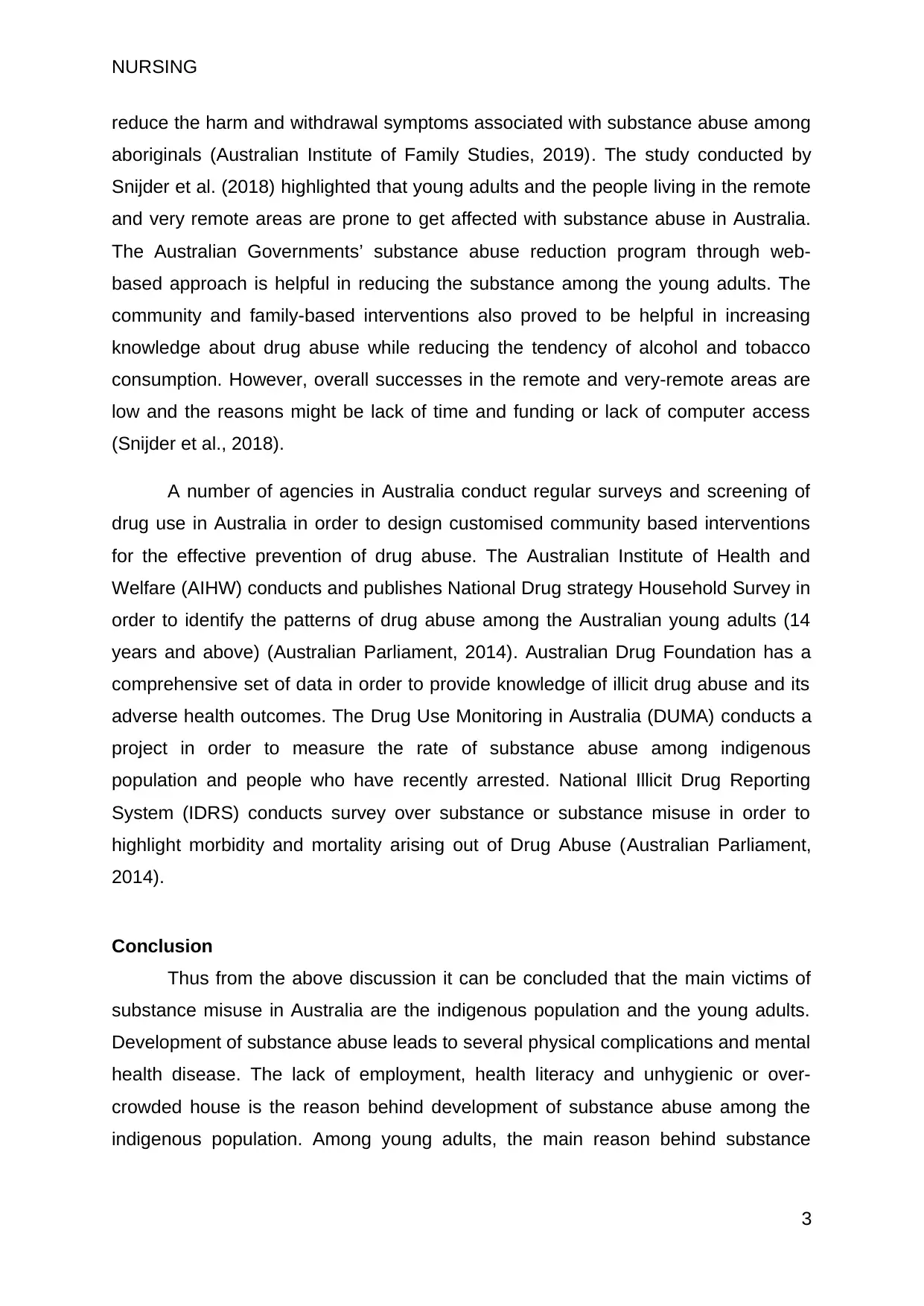
NURSING
reduce the harm and withdrawal symptoms associated with substance abuse among
aboriginals (Australian Institute of Family Studies, 2019). The study conducted by
Snijder et al. (2018) highlighted that young adults and the people living in the remote
and very remote areas are prone to get affected with substance abuse in Australia.
The Australian Governments’ substance abuse reduction program through web-
based approach is helpful in reducing the substance among the young adults. The
community and family-based interventions also proved to be helpful in increasing
knowledge about drug abuse while reducing the tendency of alcohol and tobacco
consumption. However, overall successes in the remote and very-remote areas are
low and the reasons might be lack of time and funding or lack of computer access
(Snijder et al., 2018).
A number of agencies in Australia conduct regular surveys and screening of
drug use in Australia in order to design customised community based interventions
for the effective prevention of drug abuse. The Australian Institute of Health and
Welfare (AIHW) conducts and publishes National Drug strategy Household Survey in
order to identify the patterns of drug abuse among the Australian young adults (14
years and above) (Australian Parliament, 2014). Australian Drug Foundation has a
comprehensive set of data in order to provide knowledge of illicit drug abuse and its
adverse health outcomes. The Drug Use Monitoring in Australia (DUMA) conducts a
project in order to measure the rate of substance abuse among indigenous
population and people who have recently arrested. National Illicit Drug Reporting
System (IDRS) conducts survey over substance or substance misuse in order to
highlight morbidity and mortality arising out of Drug Abuse (Australian Parliament,
2014).
Conclusion
Thus from the above discussion it can be concluded that the main victims of
substance misuse in Australia are the indigenous population and the young adults.
Development of substance abuse leads to several physical complications and mental
health disease. The lack of employment, health literacy and unhygienic or over-
crowded house is the reason behind development of substance abuse among the
indigenous population. Among young adults, the main reason behind substance
3
reduce the harm and withdrawal symptoms associated with substance abuse among
aboriginals (Australian Institute of Family Studies, 2019). The study conducted by
Snijder et al. (2018) highlighted that young adults and the people living in the remote
and very remote areas are prone to get affected with substance abuse in Australia.
The Australian Governments’ substance abuse reduction program through web-
based approach is helpful in reducing the substance among the young adults. The
community and family-based interventions also proved to be helpful in increasing
knowledge about drug abuse while reducing the tendency of alcohol and tobacco
consumption. However, overall successes in the remote and very-remote areas are
low and the reasons might be lack of time and funding or lack of computer access
(Snijder et al., 2018).
A number of agencies in Australia conduct regular surveys and screening of
drug use in Australia in order to design customised community based interventions
for the effective prevention of drug abuse. The Australian Institute of Health and
Welfare (AIHW) conducts and publishes National Drug strategy Household Survey in
order to identify the patterns of drug abuse among the Australian young adults (14
years and above) (Australian Parliament, 2014). Australian Drug Foundation has a
comprehensive set of data in order to provide knowledge of illicit drug abuse and its
adverse health outcomes. The Drug Use Monitoring in Australia (DUMA) conducts a
project in order to measure the rate of substance abuse among indigenous
population and people who have recently arrested. National Illicit Drug Reporting
System (IDRS) conducts survey over substance or substance misuse in order to
highlight morbidity and mortality arising out of Drug Abuse (Australian Parliament,
2014).
Conclusion
Thus from the above discussion it can be concluded that the main victims of
substance misuse in Australia are the indigenous population and the young adults.
Development of substance abuse leads to several physical complications and mental
health disease. The lack of employment, health literacy and unhygienic or over-
crowded house is the reason behind development of substance abuse among the
indigenous population. Among young adults, the main reason behind substance
3
Paraphrase This Document
Need a fresh take? Get an instant paraphrase of this document with our AI Paraphraser
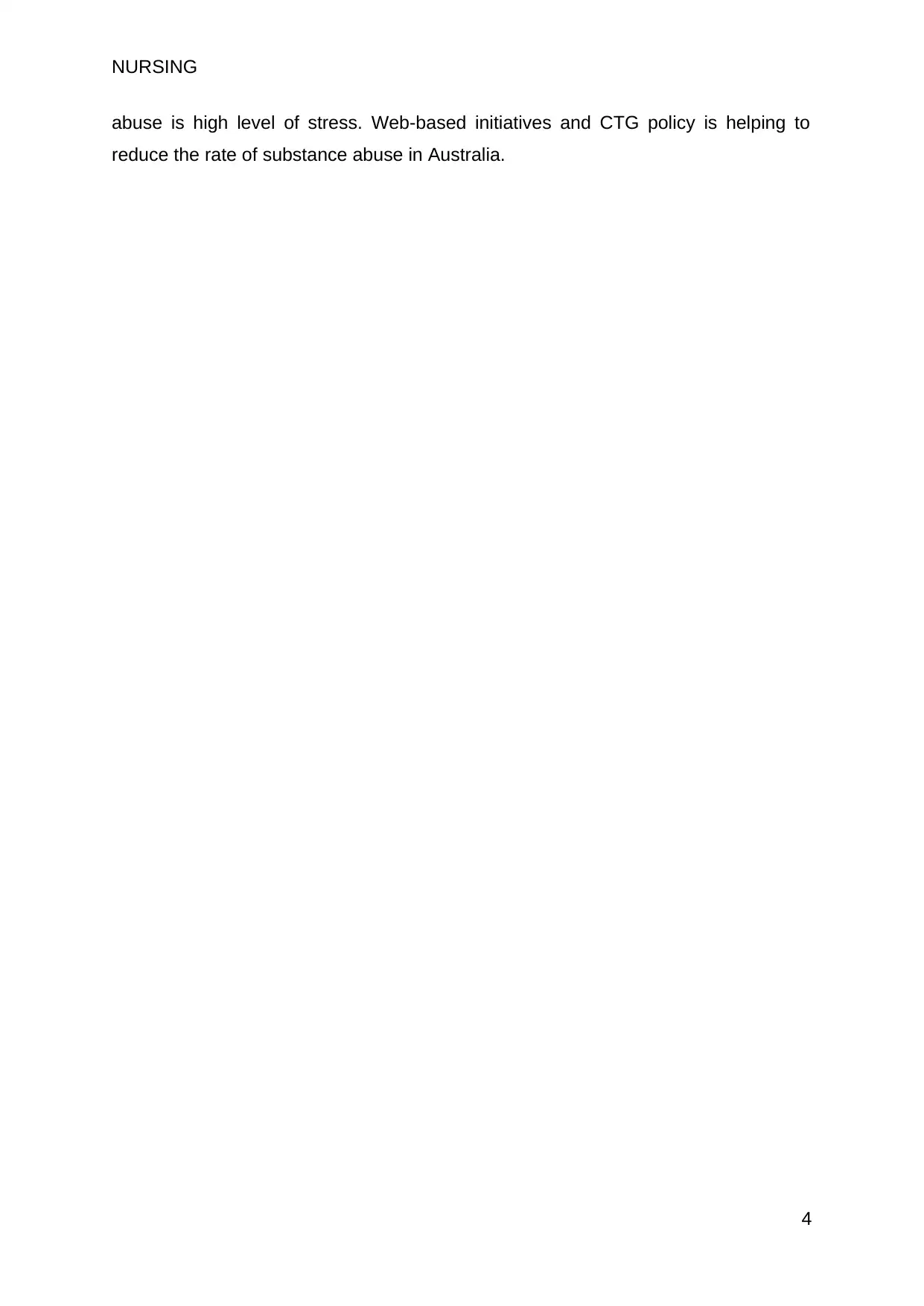
NURSING
abuse is high level of stress. Web-based initiatives and CTG policy is helping to
reduce the rate of substance abuse in Australia.
4
abuse is high level of stress. Web-based initiatives and CTG policy is helping to
reduce the rate of substance abuse in Australia.
4
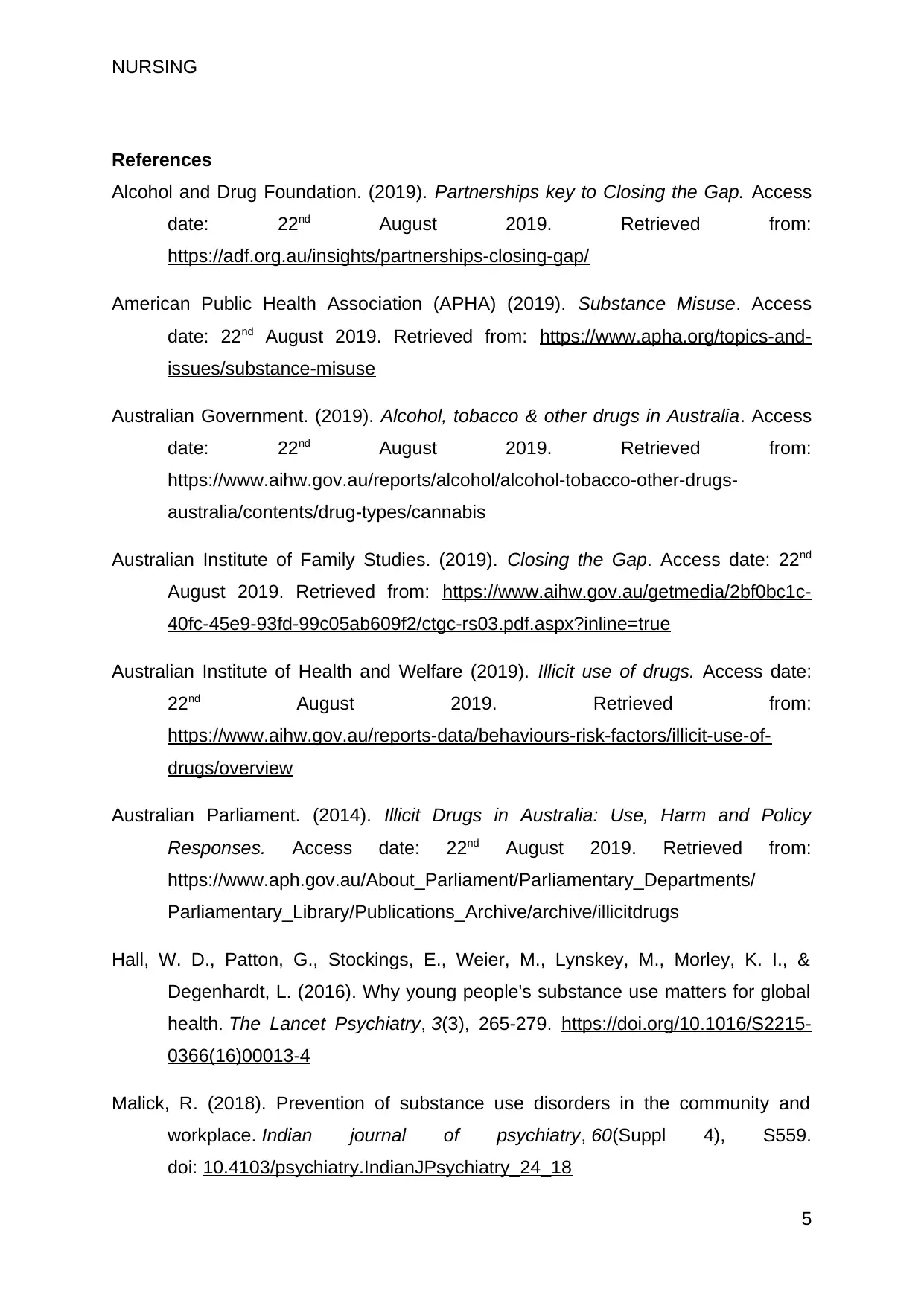
NURSING
References
Alcohol and Drug Foundation. (2019). Partnerships key to Closing the Gap. Access
date: 22nd August 2019. Retrieved from:
https://adf.org.au/insights/partnerships-closing-gap/
American Public Health Association (APHA) (2019). Substance Misuse. Access
date: 22nd August 2019. Retrieved from: https://www.apha.org/topics-and-
issues/substance-misuse
Australian Government. (2019). Alcohol, tobacco & other drugs in Australia. Access
date: 22nd August 2019. Retrieved from:
https://www.aihw.gov.au/reports/alcohol/alcohol-tobacco-other-drugs-
australia/contents/drug-types/cannabis
Australian Institute of Family Studies. (2019). Closing the Gap. Access date: 22nd
August 2019. Retrieved from: https://www.aihw.gov.au/getmedia/2bf0bc1c-
40fc-45e9-93fd-99c05ab609f2/ctgc-rs03.pdf.aspx?inline=true
Australian Institute of Health and Welfare (2019). Illicit use of drugs. Access date:
22nd August 2019. Retrieved from:
https://www.aihw.gov.au/reports-data/behaviours-risk-factors/illicit-use-of-
drugs/overview
Australian Parliament. (2014). Illicit Drugs in Australia: Use, Harm and Policy
Responses. Access date: 22nd August 2019. Retrieved from:
https://www.aph.gov.au/About_Parliament/Parliamentary_Departments/
Parliamentary_Library/Publications_Archive/archive/illicitdrugs
Hall, W. D., Patton, G., Stockings, E., Weier, M., Lynskey, M., Morley, K. I., &
Degenhardt, L. (2016). Why young people's substance use matters for global
health. The Lancet Psychiatry, 3(3), 265-279. https://doi.org/10.1016/S2215-
0366(16)00013-4
Malick, R. (2018). Prevention of substance use disorders in the community and
workplace. Indian journal of psychiatry, 60(Suppl 4), S559.
doi: 10.4103/psychiatry.IndianJPsychiatry_24_18
5
References
Alcohol and Drug Foundation. (2019). Partnerships key to Closing the Gap. Access
date: 22nd August 2019. Retrieved from:
https://adf.org.au/insights/partnerships-closing-gap/
American Public Health Association (APHA) (2019). Substance Misuse. Access
date: 22nd August 2019. Retrieved from: https://www.apha.org/topics-and-
issues/substance-misuse
Australian Government. (2019). Alcohol, tobacco & other drugs in Australia. Access
date: 22nd August 2019. Retrieved from:
https://www.aihw.gov.au/reports/alcohol/alcohol-tobacco-other-drugs-
australia/contents/drug-types/cannabis
Australian Institute of Family Studies. (2019). Closing the Gap. Access date: 22nd
August 2019. Retrieved from: https://www.aihw.gov.au/getmedia/2bf0bc1c-
40fc-45e9-93fd-99c05ab609f2/ctgc-rs03.pdf.aspx?inline=true
Australian Institute of Health and Welfare (2019). Illicit use of drugs. Access date:
22nd August 2019. Retrieved from:
https://www.aihw.gov.au/reports-data/behaviours-risk-factors/illicit-use-of-
drugs/overview
Australian Parliament. (2014). Illicit Drugs in Australia: Use, Harm and Policy
Responses. Access date: 22nd August 2019. Retrieved from:
https://www.aph.gov.au/About_Parliament/Parliamentary_Departments/
Parliamentary_Library/Publications_Archive/archive/illicitdrugs
Hall, W. D., Patton, G., Stockings, E., Weier, M., Lynskey, M., Morley, K. I., &
Degenhardt, L. (2016). Why young people's substance use matters for global
health. The Lancet Psychiatry, 3(3), 265-279. https://doi.org/10.1016/S2215-
0366(16)00013-4
Malick, R. (2018). Prevention of substance use disorders in the community and
workplace. Indian journal of psychiatry, 60(Suppl 4), S559.
doi: 10.4103/psychiatry.IndianJPsychiatry_24_18
5
⊘ This is a preview!⊘
Do you want full access?
Subscribe today to unlock all pages.

Trusted by 1+ million students worldwide
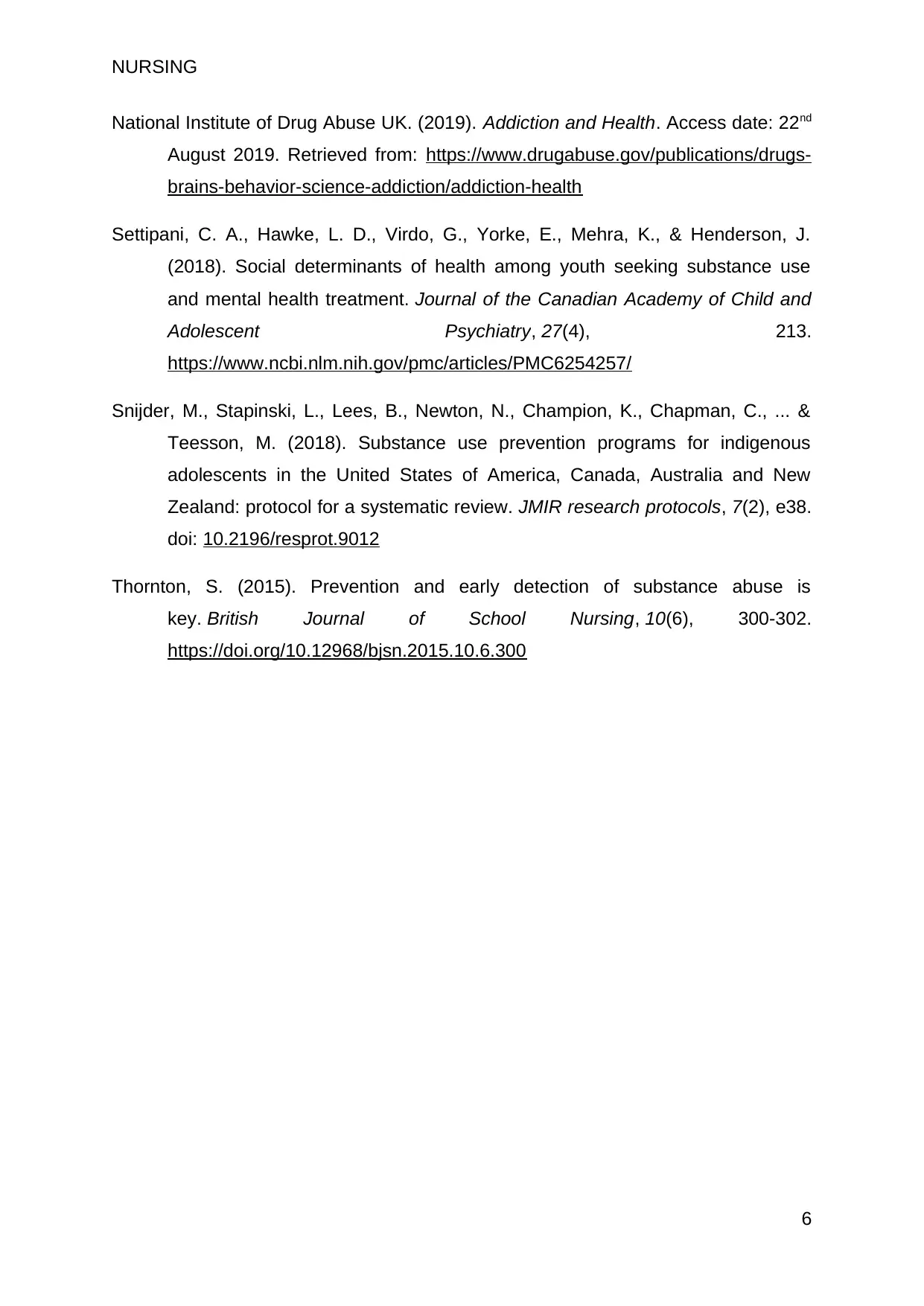
NURSING
National Institute of Drug Abuse UK. (2019). Addiction and Health. Access date: 22nd
August 2019. Retrieved from: https://www.drugabuse.gov/publications/drugs-
brains-behavior-science-addiction/addiction-health
Settipani, C. A., Hawke, L. D., Virdo, G., Yorke, E., Mehra, K., & Henderson, J.
(2018). Social determinants of health among youth seeking substance use
and mental health treatment. Journal of the Canadian Academy of Child and
Adolescent Psychiatry, 27(4), 213.
https://www.ncbi.nlm.nih.gov/pmc/articles/PMC6254257/
Snijder, M., Stapinski, L., Lees, B., Newton, N., Champion, K., Chapman, C., ... &
Teesson, M. (2018). Substance use prevention programs for indigenous
adolescents in the United States of America, Canada, Australia and New
Zealand: protocol for a systematic review. JMIR research protocols, 7(2), e38.
doi: 10.2196/resprot.9012
Thornton, S. (2015). Prevention and early detection of substance abuse is
key. British Journal of School Nursing, 10(6), 300-302.
https://doi.org/10.12968/bjsn.2015.10.6.300
6
National Institute of Drug Abuse UK. (2019). Addiction and Health. Access date: 22nd
August 2019. Retrieved from: https://www.drugabuse.gov/publications/drugs-
brains-behavior-science-addiction/addiction-health
Settipani, C. A., Hawke, L. D., Virdo, G., Yorke, E., Mehra, K., & Henderson, J.
(2018). Social determinants of health among youth seeking substance use
and mental health treatment. Journal of the Canadian Academy of Child and
Adolescent Psychiatry, 27(4), 213.
https://www.ncbi.nlm.nih.gov/pmc/articles/PMC6254257/
Snijder, M., Stapinski, L., Lees, B., Newton, N., Champion, K., Chapman, C., ... &
Teesson, M. (2018). Substance use prevention programs for indigenous
adolescents in the United States of America, Canada, Australia and New
Zealand: protocol for a systematic review. JMIR research protocols, 7(2), e38.
doi: 10.2196/resprot.9012
Thornton, S. (2015). Prevention and early detection of substance abuse is
key. British Journal of School Nursing, 10(6), 300-302.
https://doi.org/10.12968/bjsn.2015.10.6.300
6
1 out of 7
Related Documents
Your All-in-One AI-Powered Toolkit for Academic Success.
+13062052269
info@desklib.com
Available 24*7 on WhatsApp / Email
![[object Object]](/_next/static/media/star-bottom.7253800d.svg)
Unlock your academic potential
Copyright © 2020–2025 A2Z Services. All Rights Reserved. Developed and managed by ZUCOL.





